- Home
- Deceptions
- Solar
- Thermal Audit
- Ventilation
- Sensors
- Governance
- Environment
- Reference
- Contact
- News
Geothermal Heat Pumps
Main Points:
- Four to five times (75% to 80%) more efficient than electric baseboard heating
- Heat is extracted from the ground
- Remains efficient even on the coldest winter nights
- More expensive and complicated than electric baseboard
Some areas of the world, like Iceland, have nearby volcanic activity and the ground is hot. Steam can be extracted from underground pipes and used to drive power plants, or underground hot water can be used for heating. This is not what we mean by "geothermal" when referring to heat pumps.
The drawing below [1] shows a geothermal heating system where the water is drawn in from a well (could be a dual purpose drinking water well) and returned to the ground through a second well. This provides an endless supply of constant temperature water.
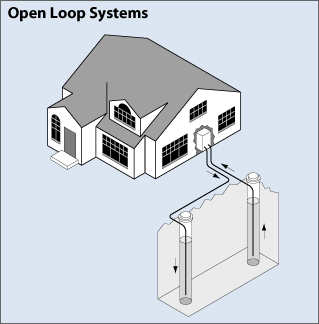
The next section shows some examples of geothermal heat pump installations in St. John's.
Photos and Commentary
new photos of local installations coming soon ...
This is an air-to-water heat pump (not geothermal) in St. John's that is heating the entire home using hot water floor heating. Until recently, only air-to-air and water-to-water types were available for home heating, although air-to-water types were available as swimming pool heaters. The propane tank behind it is for a gas fireplace. The unit is very quiet because the large fans turn slowly, and considerably quieter than most whole-house air conditioners.
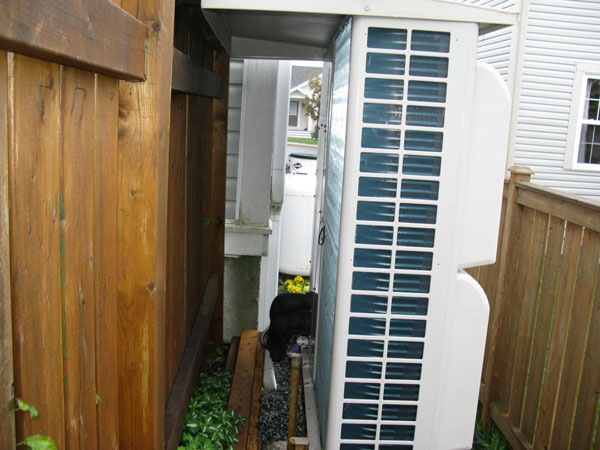
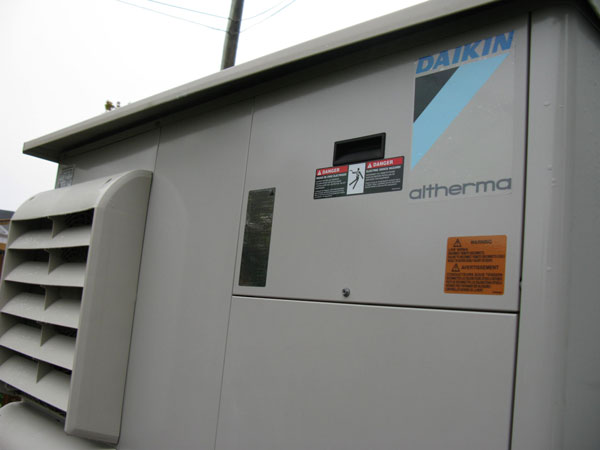
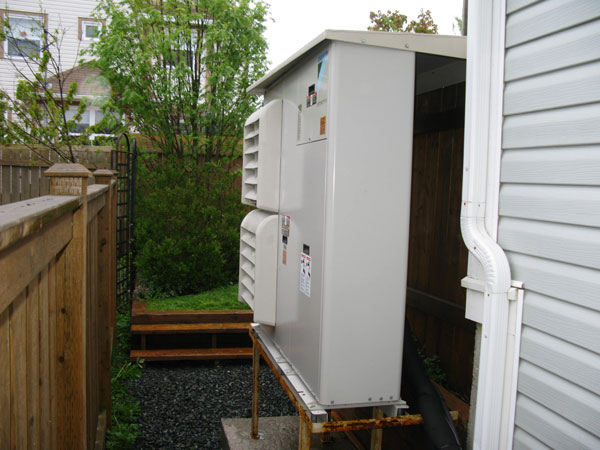
More Detailed Discussion of the workings
Main Points:
- They work on the same principle as a electric kitchen refrigerator
- Closed loop systems circulate water/antifreeze through a coil burried in the yard
- Open loop systems use a pair of wells that must be drilled
- Open loop systems are the most efficient
- Air-source systems stop working on cold winter days, and therefore cannot reduce the peak winter demand required to eliminate the Holyrood generation plant.
Most homes already have heat pumps in their refrigerator and deep freezes. The heat pump cools the freezer/fridge and heats the room. You can put your hand under or behind most refrigerators and feel the heat. Room air conditioners do the same things -- blow cold air inside and hot air outside. If you walk outside and stand in front of an air conditioner, you will get a large blast of hot air in your face.
The diagram below shows a compressor (4) that compresses a gas which then gets hot. Air flowing (1) over the coils extracts heat. A small opening (2) allows the gas to expand and cool, an effect you will see with some spray cans. Air flowing (3) over the coils is chilled. If this was your refrigerator, section B in the diagram would in the freezer compartment, and section A would be on the outside rear of the refrigerator.
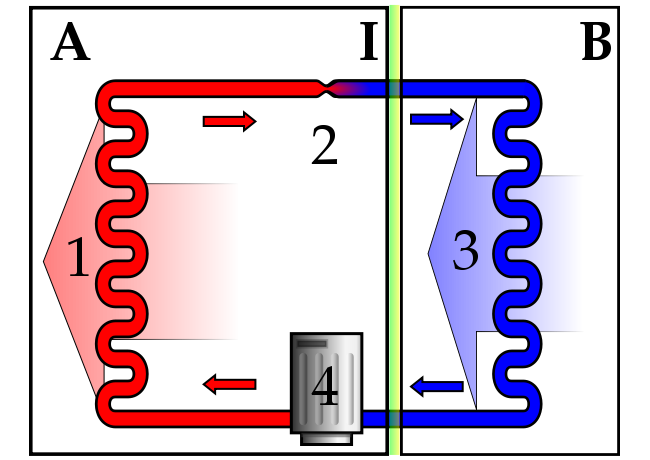
If you were to install a window mounted air conditioner backwards, you would be cooling the outdoors and heating the inside. It is not intuitive, but using an air conditioner in this way (backwards) is actually two or three times more efficient than using an electric heater. The abbreviation COP, or coefficient of performance, is used to describe efficiency A COP of one is like a light bulb. 60 watts of power in, and you get 60 watts of light and heat out. A COP of five on the other hand is almost magic. A one thousand watt air conditioner could produce 5000 watts of heat.
Refrigerators and air-conditioners use air to transfer heat to and from the coils. This works well as long as the temperature difference isn't to large between the warm and cold sides. The larger the temperature difference, the less efficient the process becomes, until it doesn't work at all.
Geothermal heat pumps use water instead of air to transfer the heat, and take advantage of the fact that well water never freezes in winter. It remains at a fairly constant temperature, somewhere around 10°C/50°F. Winter air on the other hand, can be -20°C on a really cold night. This is very important because well water guarantees that the geothermal heat pump will maintain its efficiency no matter how cold it is outside, whereas an air-to-air heat pump become less efficient as it gets colder outside, eventually becoming useless on a very cold night. Useless is a slight exaggeration because air-to-air heat pumps automatically disconnect when it gets too cold outside and turn on an electric heater instead. Therefore, if the intention of using heat pumps is to reduce winter heating load and eliminate supplemental electricity generation (e.g. Holyrood generation station) in the winter, then you have to use ground heat, not air.
There are also closed loop versions of ground source heating, where a large coil is buried in the back yard. A mix of water and antifreeze continuously circulates through the loop so that it can't freeze solid. The chief advantage is that wells do not have to be drilled. The disadvantages are that they could could leak water/antifreeze mix and you'd have to dig it all up, and the efficiency is lower because the ground cools down. The wells used in open loop systems don't cool down because water is constantly migrating through the underground aquifers.
Spreading a coil like this, using plastic pipe (like PEX) before backfilling new construction could be very inexpensive, and ensure that all new homes were geothermal ready.

From a homeowner's point of view, an air-to-air heat pump might be a better value because there are no wells to drill, it costs less, and is still a big improvement on baseboard heaters. In the United States, air source heat pumps are very popular and also serve as air conditioners.
However, this is where you have to look at a bigger picture and consider the entire province instead of the house. If everyone wants full electric capacity on the coldest nights in February without rotating blackouts or load shedding like you get in many countries today - including Japan, than you have to spend billions of dollars on thermal generator stations or consider mega-projects like bringing power from Labrador. You pay for this capacity indirectly -- through higher taxes, cutbacks in essential services like health care and roads -- simply because there isn't enough money to go around.
The ultimate solution of course is to not need the heat in the first place. The money spent on the heat pump system could be spent on building a better house. It is possible to create homes that are so well insulated and designed, that they are inhabitable even without heating. Root cellars don't freeze in winter and Igloos can reach 17C inside when it is below -30C outside. Add south facing windows, shutters, thicker walls and heavy flooring materials to absorb heat and you end up with a modern solar passive home.
System Costs
Main points:
- Systems cost is approximately $21,000 or about 5% of the value of the average home in St. John's.
- Government assistance would increase the adoption rate for retrofits
- Mandatory use of heat pumps in new homes and commercial buildings is the best method
A geothermal heat pump should last as long as a refrigerator, which could be 30 years or more if maintained properly. It is a good candidate to be considered a permanent part of the home, and incorporated into the mortgage. The average system prices for closed loop systems in 2010 [2] are as follows:
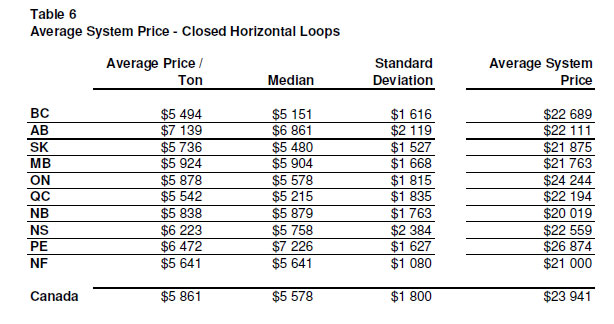
Open loop systems would cost more depending on the well arrangement, or possibly less if they were shared by neighbours.
The real savings come from mandating heat pumps or solar passive techniques on new construction. The heat pump is approximately 5% of the price of a new home in Canadian cities, and given that the home size and prices are a function of what people can qualify to mortgage -- there would be no change in price. Instead, the homes would be smaller, land prices lower, or someone would make less profit.
Fuel Replaced by Retrofits
Main Points:
- Some people will relace oil heat with geothermal, which will result in an increase in power demand
- To reduce power demand, users of electric heat must be targeted
- Pellet stoves that burn local biomass should also be encouraged
Unfortunately, there was not not enough data available for the Canadian GeoExchange Coalition report to determine the breakdown of closed loop versus open loop and the fuel replaced. Below are a the charts for Nova Scotia instead.
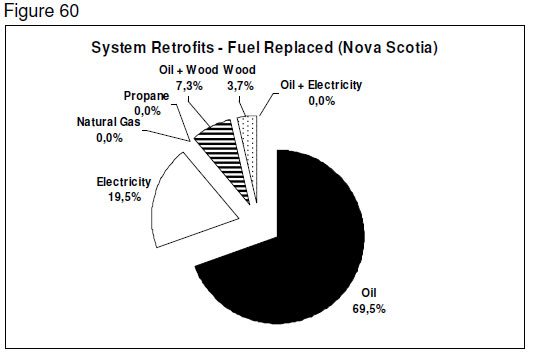
This is particularly interesting because replacing oil heat, while important for sustainability, doesn't help the winter peak demand problem, and actually increases demand. In this example, pretend there are 100 homes and it takes 4 units of power (arbitrary) to heat a home with electric heat, and 1 unit to use a heat pump. The 80 homes that switched from wood, oil and gas to heat pump now need 80 new units of power. The 20 electric homes, used to use 80 units but now use 20 for a savings of 60. The net result is that demand went up by 20, or 5%. Renewable, non-electric heating such as pellet stoves should be encouraged to offset this.
